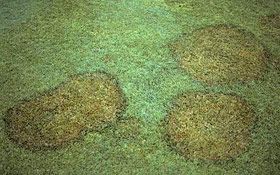Brown Patch, Rhizoctonia solani

Photo from Brown Patch, Penn State Center for Turfgrass Science.
IPM Steps to Reduce Brown Patch
1. Sample for Pest
Confirm the presence of brown patch before you treat.
Where to find it while inspecting: Found on ryegrass, tall fescue, and bentgrass turf, and occasionally on Kentucky bluegrass during high humidity in mid to late summer. Look for patches 2" to several feet in diameter. Affected grass shows up as thinned spots. In severe cases, dead grass appears as black and sunken areas. Look for white mycelium (threadlike structures) on wet grass in early morning. On fescue in particular, brown patch tends to appear as irregular lesions on individual grass blades rather than in patches of grass. Lesions are light brown surrounded by dark brown borders.
2. Proper ID
Is it brown patch?
Size and Appearance: 2–24" patches, or as brown spots on the blades of tall fescue.
3. Learn the Pest Biology
What is the life cycle of brown patch?
Life Cycle: The fungus overwinters in leaf tissue or soil and becomes active under certain weather conditions. Moist weather and high temperatures (nighttime 68 degrees/daytime 80 degrees). High humidity at these temperatures pushes infestation.
Preferred food sources: Fungal diseases obtain nutrients from the breakdown of organic matter.
Preferred Habitat: Perennial ryegrass, tall fescue and bentgrass. Occasionally Kentucky bluegrass.
4. Determine Threshold
How much brown patch is too much?
Threshold: Dependent upon aesthetic needs of the turf; it can be maintained without treatment.
5. Choose Tactics
Creating a healthy soil condition and understanding turfgrass’s needs is the first step in reducing turf pests. What can I do to treat, reduce, or prevent Rust Diseases of Turf?
Best Management Practices: Do not apply nitrogen fertilizers with previous brown patch problems if the weather looks to be hot and humid. Removing excess water (dew) by mowing or dragging helps.
Treatment Methods: On high end turf with histories of brown patch damage, emergency applications of fungicide can be applied at the immediate onset of disease if weather is expected to be hot and humid for an extended period.
6. Evaluate
Was the tactic successful? Record the date pests were first noted, and the tactic you used, and its success. Use one of our RECORD KEEPING tools.
For More Information:
Penn State Plant Science: Brown Patch
Remember:
When a pesticide application is necessary, all necessary and required precautions are taken to minimize risk to people and the environment and to minimize risk of pesticide resistance or pest resurgence. Pesticide use in your school may be prohibited or regulated by local policies or state and federal regulations. Risk reduction methods can include, but are not limited to, spot-treatment, the use of gel or paste bait formulations placed in inaccessible locations, injection into a crack or crevice, and other methods that reduce potential exposure.